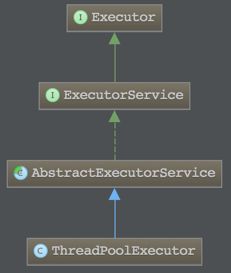线程池的作用
暂且不表
线程池
java提供的线程池类是ThreadPoolExecutor。
下图是类ThreadPoolExecutor的继承关系
使用线程池,我们一般关心以下几个场景:
- 为了控制线程数量,需要固定线程池大小
- 希望压力小时线程少点,压力大时多创建点线程。压力再次减小时,多余的线程过一段时间自动销毁,以节省资源
- 当请求过多时,多余的请求放入什么样的等待队列中。
- 当请求太多,连队列都放不下的时候,应采取什么样的抛弃策略。
鉴于以上场景,ThreadPoolExecutor有4个构造函数,能够满足所有的需求:
public class ThreadPoolExecutor extends AbstractExecutorService {
public ThreadPoolExecutor(int corePoolSize,int maximumPoolSize,long keepAliveTime,TimeUnit unit,
BlockingQueue workQueue);
public ThreadPoolExecutor(int corePoolSize,int maximumPoolSize,long keepAliveTime,TimeUnit unit,
BlockingQueue workQueue,RejectedExecutionHandler handler);
我们需要先看看构造函数的参数都是什么意思:
int corePoolSize: 线程池中alive线程的最少数量。
默认情况下,创建线程池后,线程池中是没有任何线程的。线程的创建延迟到了请求到达的时候。也就是说,一开始线程池中线程数量是0,来一个请求就创建一个线程。当线程数量达到corePoolSize时,线程池中线程的数量最少为corePoolSize
int maximumPoolSize: 线程池中最大线程数量。
在maximumPoolSize>corePoolSize的情况下,线程池中线程数量可超过corePoolSize,以应对过大的压力。当压力降下来的时候,一部分线程过一段时间会自动销毁,直至数量减少到corePoolSize。如果maximumPoolSize=corePoolSize,那么线程池的大小就是固定的了。
Q: 线程数什么时候才会超过corePoolSize呢?
A: 多余的请求会先进入等待队列,当等待队列满了的时候,会创建新的线程来处理请求(前提是maximumPoolSize>corePoolSize),线程数最大为maximumPoolSize。当还有更多请求时,就要采取抛弃策略了。
Q: 那岂不是新请求会被先执行?
long keepAliveTime和TimeUnit unit: 线程存活时间
maximumPoolSize中提到线程数量可以超过corePoolSize。这些额外的线程过多场时间销毁呢?就是由keepAliveTime和unit决定的。keepAliveTime是个数字,unit表示时间。TimeUnit的可选值有:
- TimeUnit.DAYS; //天
- TimeUnit.HOURS; //小时
- TimeUnit.MINUTES; //分钟
- TimeUnit.SECONDS; //秒
- TimeUnit.MILLISECONDS; //毫秒
- TimeUnit.MICROSECONDS; //微妙
- TimeUnit.NANOSECONDS; //纳秒
如keepAliveTime=1,unit为TimeUnit.MINUTES,表示多余的线程过1分钟后销毁。
BlockingQueue:等待队列,存放等待的请求。当线程数达到corePoolSize时,再来的请求会放入等待队列
- ArrayBlockingQueue: 基于数组的先进先出队列,此队列创建时必须指定大小;
- LinkedBlockingQueue: 基于链表的先进先出队列,可以指定大小。如果创建时没有指定此队列大小,则默认为Integer.MAX_VALUE;
- SynchronousQueue: 这个队列比较特殊,它不会保存提交的任务,而是将直接新建一个线程来执行新来的任务。
RejectedExecutionHandler handler: 线程池中线程不够用,队列也放不下了,采取什么样的策略处理新请求。
- ThreadPoolExecutor.AbortPolicy:丢弃任务并抛出RejectedExecutionException异常。
- ThreadPoolExecutor.DiscardPolicy:也是丢弃任务,但是不抛出异常。
- ThreadPoolExecutor.DiscardOldestPolicy:丢弃线程队列里最近的一个任务,执行新提交的任务
- ThreadPoolExecutor.CallerRunsPolicy:用调用者的线程来运行任务
根据实际需求,设置好以上这些参数,就能创建出一个可用的线程池。
除了上面的两个构造函数,ThreadPoolExecutor还提供了支持ThreadFactory创建线程的构造函数。如下:
public ThreadPoolExecutor(int corePoolSize,int maximumPoolSize,long keepAliveTime,TimeUnit unit,
BlockingQueue workQueue,ThreadFactory threadFactory,RejectedExecutionHandler handler);
public ThreadPoolExecutor(int corePoolSize,int maximumPoolSize,long keepAliveTime,TimeUnit unit,
BlockingQueue workQueue,ThreadFactory threadFactory);
}
ThreadFactory的作用......
有了ThreadPoolExecutor,只需设置一些参数就可以拥有一个线程池,是不是很简单!是!但是还可以更简单。
程序员一直都有懒的天性。因为懒,所以才创造出了各种工具、各种语言。秉承着懒懒更健康的原则,对于常见线程池,JDK提供了创建工具Executors
Executors
Executors是一个创建线程池的工具类。它提供了最常见的线程池的创建方法。不需要我们再苦思冥想设置参数了,只需选择合适的函数,一个最通用的线程池就创建了。
Executors主要提供了以下四种工具:
- newFixedThreadPool(int nThreads): 创建线程数量固定的线程池。
- newSingleThreadExecutor(): 创建只有一个线程的线程池。
- newCachedThreadPool(): 创建不限制线程数量的线程池。
- newScheduledThreadPool(int corePoolSize): 创建一个定时调度的线程池。
源码如下:
public class Executors {
public static ExecutorService newFixedThreadPool(int nThreads) {
return new ThreadPoolExecutor(nThreads, nThreads,
0L, TimeUnit.MILLISECONDS,
new LinkedBlockingQueue());
}
public static ExecutorService newSingleThreadExecutor() {
return new FinalizableDelegatedExecutorService
(new ThreadPoolExecutor(1, 1,
0L, TimeUnit.MILLISECONDS,
new LinkedBlockingQueue()));
}
public static ExecutorService newCachedThreadPool() {
return new ThreadPoolExecutor(0, Integer.MAX_VALUE,
60L, TimeUnit.SECONDS,
new SynchronousQueue());
}
public static ScheduledExecutorService newScheduledThreadPool(int corePoolSize){
new ScheduledThreadPoolExecutor(corePoolSize);
}
}
通过源码,我们可以知道:
- newFixedThreadPool(int nThreads)创建的线程池其实就是corePoolSize=maximumPoolSize,使用无界队列的线程池
- newCachedThreadPool()创建的线程池其实是corePoolSize=0,maximumPoolSize=Integer.MAX_VALUE,线程闲置60s后自动销毁,同样使用无界队列的线程池。
抛弃策略是啥?
有人可能发现工具类中没有提供抛弃策略的参数。其实是使用了默认的抛弃策略:
private static final RejectedExecutionHandler defaultHandler = new AbortPolicy();
Executors中还有其他创建线程池的方法,可自行查阅,选取适合自己需求的使用。
线程池的常用操作
Future submit(Runnable task);
向线程池中提交一个
Runnable类,返回一个Future对象。当调用get()方法时,会阻塞。线程结束时,返回null。
向线程池中提交一个
Runnable类,返回一个Future对象。当调用get()方法时,会阻塞。线程结束时,返回传入的result。
向线程池中提交一个
Callable类,返回一个Future对象。当调用get()方法时,会阻塞。线程结束时,返回执行结果。
void shutdown();
关闭线程。已经submit的会继续执行直至结束,不会再接收新的任务
List
如果
shutdown()时,有线程在一直执行,不结束,总不能一直等吧。shutdownNow()会结束所有的线程,返回结果是所有等待任务。
Executor & ExecutorService & Executors
public interface Executor {
void execute(Runnable command);
}
public interface ExecutorService extends Executor {
void shutdown();
Future submit(Callable task);
Future submit(Runnable task, T result);
List> invokeAll(Collection> tasks, long timeout, TimeUnit unit) throws InterruptedException;
}
public interface ExecutorService extends Executor {
void shutdown();
Future submit(Callable task);
Future submit(Runnable task, T result);
List> invokeAll(Collection> tasks, long timeout, TimeUnit unit) throws InterruptedException;
}
- Executor 和 ExecutorService 这两个接口主要的区别是:ExecutorService 接口继承 Executor 接口,是 Executor 的子接口
- Executor 和 ExecutorService 第二个区别是:Executor 接口定义了 execute()方法用来接收一个Runnable接口的对象,而 ExecutorService 接口中的 submit()方法可以接受Runnable和Callable接口的对象。
- Executor 和 ExecutorService 接口第三个区别是 Executor 中的 execute() 方法不返回任何结果,而 ExecutorService 中的 submit()方法可以通过一个 Future 对象返回运算结果。
- Executor 和 ExecutorService 接口第四个区别是除了允许客户端提交一个任务,ExecutorService 还提供用来控制线程池的方法。比如:调用 shutDown() 方法终止线程池。可以通过 《Java Concurrency in Practice》 一书了解更多关于关闭线程池和如何处理 pending 的任务的知识。
- Executors 类提供工厂方法用来创建不同类型的线程池。比如: newSingleThreadExecutor() 创建一个只有一个线程的线程池,newFixedThreadPool(int numOfThreads)来创建固定线程数的线程池,newCachedThreadPool()可以根据需要创建新的线程,但如果已有线程是空闲的会重用已有线程。
应用实例
理论再多,不如看实际应用中的源码:
metrics-core定时report源码:
public abstract class ScheduledReporter{
private final ScheduledExecutorService executor;
protected ScheduledReporter(MetricRegistry registry,
String name,
MetricFilter filter,
TimeUnit rateUnit,
TimeUnit durationUnit) {
this(registry, name, filter, rateUnit, durationUnit,
Executors.newSingleThreadScheduledExecutor(new NamedThreadFactory(name + '-' + FACTORY_ID.incrementAndGet())));
}
public void start(long period, TimeUnit unit) {
executor.scheduleAtFixedRate(new Runnable() {
@Override
public void run() {
try {
report();
} catch (RuntimeException ex) {
LOG.error("RuntimeException thrown from {}#report. Exception was suppressed.", ScheduledReporter.this.getClass().getSimpleName(), ex);
}
}
}, period, period, unit);
}
public void stop() {
executor.shutdown(); // Disable new tasks from being submitted
try {
// Wait a while for existing tasks to terminate
if (!executor.awaitTermination(1, TimeUnit.SECONDS)) {
executor.shutdownNow(); // Cancel currently executing tasks
// Wait a while for tasks to respond to being cancelled
if (!executor.awaitTermination(1, TimeUnit.SECONDS)) {
System.err.println(getClass().getSimpleName() + ": ScheduledExecutorService did not terminate");
}
}
} catch (InterruptedException ie) {
// (Re-)Cancel if current thread also interrupted
executor.shutdownNow();
// Preserve interrupt status
Thread.currentThread().interrupt();
}
}
}
参考
- 深入理解Java之线程池
- Executor, ExecutorService 和 Executors 间的不同
- 深入分析java线程池的实现原理
